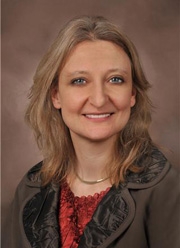 Cody Artist went through years of escalating pain before he met Beth Schrope, MD, PhD. Director of NYP/Columbia’s Autologous Islet Cell Transplantation program, and the first to perform this operation in the New York area. This procedure finally ended his attacks and gave him back his life.
Cody Artist went through years of escalating pain before he met Beth Schrope, MD, PhD. Director of NYP/Columbia’s Autologous Islet Cell Transplantation program, and the first to perform this operation in the New York area. This procedure finally ended his attacks and gave him back his life.
In high school, Cody was a football player (six feet tall and 205 pounds) and a natural leader. But halfway through his junior year, the troubling symptoms started—nausea and stomach pain, followed by a sudden weight loss. When the pain intensified, Cody put on his earphones, and played the drums, hoping to beat it out. A local gastroenterologist pegged this as irritable bowel syndrome or anorexia but the medications for these conditions didn’t work. The pain intensified and Cody continued to lose weight. Later that year, Cody’s primary care physician did a standard blood test and found elevated levels of the pancreatic enzymes, amylase and lipase—150 times the norm. He suspected pancreatitis, a condition where too many digestive enzymes are released, causing inflammation and, eventually, scarring of the pancreas.
In about 70 percent of patients, chronic pancreatitis is brought on by long-time alcohol use yet Cody wasn’t much of a drinker or a partier. Other causes include gallstones, hereditary disorders of the pancreas, cystic fibrosis, high cholesterol, and certain medicines. But Cody’s other test results were fine, and there was no pancreatic disease in his family.
A week before his 18th birthday in December, 2011, Cody couldn’t keep down any food and was severely dehydrated. He was hospitalized and his doctors put a stent in his pancreas, bringing temporary relief. Months passed and while away at college in Virginia, he gained some weight and seemed to be improving. Then he had an attack so severe that a surgeon had to cut the muscle around his pancreas, giving the inflamed organ room to expand. Cody recovered in time to attend the presidential inauguration in January, 2013 but later that year his symptoms worsened and he had to drop out of school.
This time Cody’s family took him to a noted specialist in New England. After many tests, the doctor gave Cody some confounding news “It’s not your pancreas. I don’t know what’s going on. But there’s nothing I can do to help.” “I left his office swearing up and down,” Cody said. “From then on, I tried to manage this disease myself. Whenever I had an attack, my mom made batches of homemade chicken soup. I ate as much as I could keep down. I drank gallons of Gatorade, and slept a lot. I did this until my symptoms finally let up. At the same time, I weaned myself off pain killers since I didn’t like the side-effects.”
 In November 2013 Cody had his gallbladder removed but this didn’t bring relief. “By the end of 2014, the attacks were coming back to back,” he says, “and every day was a living agony.” After many more months of suffering and weighing options, Cody came to Columbia and met with Dr. Schrope. When she heard Cody’s history, she said, “I have no doubt you have pancreatitis. But the good news is we have a new procedure that might help you.”
In November 2013 Cody had his gallbladder removed but this didn’t bring relief. “By the end of 2014, the attacks were coming back to back,” he says, “and every day was a living agony.” After many more months of suffering and weighing options, Cody came to Columbia and met with Dr. Schrope. When she heard Cody’s history, she said, “I have no doubt you have pancreatitis. But the good news is we have a new procedure that might help you.”
By now scar tissue had formed in Cody’s pancreas, causing his excruciating pain. In such situations, Dr. Schrope usually recommends removing the organ completely. “This renders a patient diabetic,” she says, "unless we can ‘shake out’ the islet cells, that control the body’s ability to process sugar, and implant them in the liver.” In this new location, islet cells can still produce insulin, acting like a backup pancreas. Afterward only a third of all patients will need some form of insulin replacement. One third need none at all. And because the islet cells are taken from the patient’s own pancreas, there is no need for immunosuppressant therapy.
In the weeks ahead, Cody would need more help from the Columbia team. Over time, he had developed a fistula, an abnormal connection between his stomach, his intestine, and his surgical scar. Dr. Schrope scheduled a repair, and just before surgery, it was found that Cody had a developed a heart condition. “This came from the stress of trying to tough it out, and manage my disease without the pain killers,” he said. Dr. Schrope and Columbia cardiologists worked together seamlessly to correct these problems and by September 2016 Cody was on the road to recovery.
Along with a regular regime of walks and physical therapy, he is now fishing, hanging out with friends, and starting to think about a career in national security. “Since this operation, I have had no more pain.” Cody reports. “After a few months of recovery at home I was back on solid foods, and slowly introducing things I hadn’t been able to enjoy in a long time like nuts and beef. I had to stick to a diabetic diet but was just glad to have a regular meal again.”
Another patient at Columbia played a big role in Cody’s rehabilitation. “This guy had the same surgery and as many complications as I did and he's doing really well,” says Cody. “He inspired me to take my life back. Now I’d like to help others as a spokesperson for this illness and this new treatment.”
